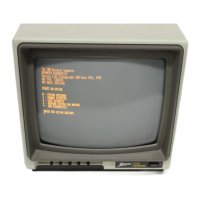II
PRODUCT SAFETY
SERVICING
GUIDELINES
CAUTION:
Do
not
attempt to modify any circuit.
Perform service work only after
you
are thoroughly
familiar
with
all of
the
following safety checks
and
servicing guidelines. To do otherwise increases the
risk of potential hazards
and
injury to the user. CAU-
TION:
Never
attempt
to service a chassis
that
is
con-
nected directly to
an
AC
line.
Make
sure
it
is con-
nected
through
an
isolation transformer. No
matter
which
way
the
AC
plug
is
inserted, a potential
shock
hazard
is
present
at
chassis
ground
unless
you use
an
isolation
transformer
during
servicing.
Since one side of the
AC
input
is fused; there's a
50% chance you'll blow a fuse,
or
a
50%
chance
you'll destroy components and/or test equipment
without
an
isolation transformer.
The
chassis con-
sists of a single circuit board
mounted
horizontally
in the bottom of
the
cabinet. All circuit parts are
mounted
on
the
board except the
CRT
and
deflection
yoke. The horizontal sweep transformer is also
mounted
on
the chassis circuit board. You
can
slide
the board
out
of the cabinet
without
disconnecting
it, and the Monitor will operate
with
the board ex-
posed. Screws are
not
required to
hold
the board
in place.
It
slides into slots
which
are molded into
the cabinet,
and
the
cabinet back holds
it
in
place.
SAFETY CHECK
After the original service problem has been cor-
rected, check for
the
following:
FIRE
&:
SHOCK
HAZARD
1.
Be
sure that all components are positioned
in
such
a way to avoid
the
possibility of adjacent
component shorts. This is especially impor-
tant
on
those chassis
which
are transported
to
and
from
the
repair shop.
2.
Never release a repair unless all protective de-
vices
such
as insulators, barriers, cover
shields, strain reliefs,
and
other hardware
have been reinstalled
per
the original design.
3. Inspect the soldering for possible cold solder
joints, frayed leads, damaged insulation (in-
cluding
AC
cord), solder splashes or sharp
solder points. Remove all loose foreign parti-
cles.
4.
5.
6.
Check "across-the-line" capacitors
and
other
components for physical evidence of damage
or
deterioration,
and
replace
them
if neces-
sary. Follow the original layout, lead length,
and
dress.
No lead
or
component
should
touch
a receiv-
ing tube
or
a resistor rated at 1
watt
or
more.
Avoid lead tension
around
protruding metal
surfaces.
Always replace critical components (shaded
on
the Schematic Diagram
and
parts lists)
such as: fuses, flameproof resistors,
capacitors, etc.
with
exact Zenith types.
Do
not
use replacement components other
than
those specified
or
make unrecommended cir-
cuit
modifications.

